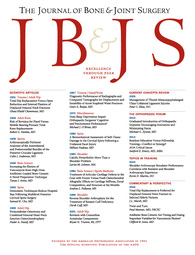
SHOULDER & ELBOW
Reverse Shoulder Arthroplasty: A Comparison of Concentric and Eccentric Glenospheres
This report has been verified
by one or more authors of the
original publication.
J Bone Joint Surg Am. 2014 Aug 20;96(16):e138
50 consecutive patients, who were undergoing reverse shoulder arthroplasty due to the diagnosis of cuff tear arthroplasty, were randomly assigned to either receive a concentric or an eccentic glenosphere. This study aimed to investigate whether the inferior positioning of the center of rotation with eccentric glenosphere designs decreases the adduction deficit before impingement occurs and improves clinical outcome. No difference was found in the notching rates and clinical outcomes between either group following the reverse shoulder arthroplasty procedure. Inferior glenosphere overhang greater than 3.5mm was shown to prevent scapular notching.
Unlock the full ACE Report
You have access to {0} free articles per month.Click below to unlock and view this {1}
Unlock NowCritical appraisals of the latest, high-impact randomized controlled trials and systematic reviews in orthopaedics
Access to OrthoEvidence podcast content, including collaborations with the Journal of Bone and Joint Surgery, interviews with internationally recognized surgeons, and roundtable discussions on orthopaedic news and topics
Subscription to The Pulse, a twice-weekly evidence-based newsletter designed to help you make better clinical decisions
Exclusive access to original content articles, including in-house systematic reviews, and articles on health research methods and hot orthopaedic topics
Or upgrade today and gain access to all OrthoEvidence content for just $1.99 per week.
Already have an account? Log in


Subscribe to "The Pulse"
Evidence-Based Orthopaedics direct to your inbox.
{0} of {1} free articles
Become an OrthoEvidence Premium Member. Expand your perspective with high-quality evidence.
Upgrade Now













































































